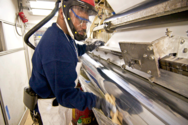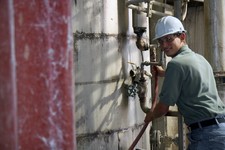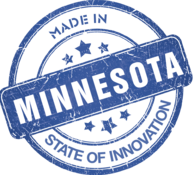|
In this issue
- Small business VOC reduction
- Clear Lake Press keeps on greening
- MNTAP interns and solid waste trainings
- Made in Minnesota solar incentive amounts set for 2014
- The right suppliers right here in MN
- Hennepin County business recycling grants available
- Area Source Boiler Rule – new videos and Jan 20 deadline
- Ideas from the web
 The Minnesota Pollution Control Agency is looking for small businesses interested in reducing emissions of volatile organic chemicals (VOCs) throughout their facilities. VOCs can be reduced by making changes to manufacturing processes and heating equipment, and through facility-wide opportunities such as reducing vehicle miles traveled, purchasing low VOC supplies, and improving energy efficiency.
This is an exciting opportunity to reduce VOCs facility-wide. If you have been thinking about reducing your VOC emissions, you can receive notifications on upcoming assistance opportunities by signing up for emails here.
|
 Clear Lake Press, a national printer
in Waseca, has all but eliminated hazardous chemicals and replaced them with
solutions that are safer for employees and the environment.
The quest to go green is not new to
Clear Lake Press. “Environmental initiatives have always been in place here,”
said Chris Waldron, VP and general manager for Clear Lake Press. The company
has been a member of the Printing Industry of Minnesota’s (PIM) Great Green
Printers since 1997. “Being a green
printer is much more than just using recycled paper and being FSC certified,”
said Gene Ross, pressroom supervisor at Clear Lake Press. “In order to make a
large-scale commercial printer run, chemicals are required to clean and wash
the blankets and rollers. Most people don’t realize those chemicals can be
hazardous.”
Changing for the better
Clear Lake Press has concentrated on
reducing hazardous waste. They went to a UV-reactive soy-based ink that needs
UV light to dry, which means the press always has wet ink to clean off before
printing a new run. Before the changes, the company used a cleaner that would
simply dissolve the ink on the rollers. With the soy-based ink, the pressmen
use a water-based cleaner instead. It takes a little more muscle to get the
machines clean, but the employees think it’s worth it. They now use a vegetable-based
cleaning solution to clean presses, and have replaced solvent-based fluids with water-based fluids in all parts washers.
The press has also reduced paper consumption by 40 rolls every month by using more efficient printing methods and increasing employee
awareness. For example, if an employee runs the machine more slowly during the test
print, less waste paper is produced. “Self-awareness and training are really
90% of it,” Waldron said. “The press was really made faster by turning the
speed down, and it wasted less.” The employees are also reminded visually.
Instead of putting all the wasted paper in bins where the employees couldn’t
see the result, it is stacked on pallets that are set in the work area. Strong
said. “The workers actually got to see the waste pile up.”
They have also worked with some of their
shippers to reuse pallets that would normally be thrown away. Instead of
dooming the wooden pallets to the mulch machine, the contractor replaces a
few boards so the pallet is usable again. Used ink is fuel-blended, and the ash
by-product is used in concrete. Garbage is contracted out to a company in
Mankato that burns the garbage for energy. Overall, only about 40 to 60 pounds
of ash goes into a landfill.
“Less than 1% of all our waste
enters a landfill,” Waldron said. “We track it, so we know exactly how much we
waste.” These kinds of results are then reported back to the employees. The
employees are told about waste produced and the resultant savings. That is
important to Waldron since he says without employee buy-in, the changes wouldn’t
work. Each of the 34 employees has had the training to sort materials, run the
machines more efficiently, and clean up using the new materials. The waste-reduction initiatives worked because the company committed to changing its workplace culture.
The bottom line
Since making the transition to green
printing, Clear Lake Press has:
- reduced VOCs by 92%
- eliminated hazardous waste
- eliminated 1,560 pounds of hazardous parts cleaner
fluid
- Reduced paper
waste from 13.6% to 5.1%
With the new improvements, Clear
Lake Press is also saving money. The company has fewer paper purchases and
hazardous waste licenses fees (moved
from SQG in 2008 to MQG status now).The
savings, Waldron said, are then passed on to the customer. By their dedication
to going green, Waldron also thinks the customers see they care. That won’t
attract every customer, but for some, it is a good selling point.
“The decision to go green was easy,”
said Waldron. “We saw an opportunity to provide a safer work place for our
employees and be more environmentally responsible, not to mention that more and
more of our customers want to do business with environmentally conscious
vendors.
|
 Intern Program Looking for
Projects - Apply Now!
The Minnesota Technical Assistance Program (MnTAP) is
currently seeking project proposals from Minnesota businesses for its 2014
summer intern program. Businesses interested in reducing waste, conserving
water, and improving energy efficiency are encouraged to apply for an intern in
2014. Proposed projects are evaluated for impact potential, project scope, and
company interest and commitment. Projects should focus on identifying specific
operations and options for reducing waste and increasing energy efficiency.
Project proposals are due on February 1, 2014.
Apply online today! If you work with Minnesota
companies, please spread the word to those companies you think might be a good
fit for such opportunities.
Solid Waste Trainings and
On-Site Assessments
The Minnesota Technical Assistance Program (MnTAP) at the
University of Minnesota is providing solid waste
trainings and on-site assessments free to attendees in 53
Minnesota counties through partnerships with counties, cities, tribal entities,
Chambers, Rotaries, and other civic organizations. This effort is supported by
a grant from United States Department of Agriculture Rural Development.
Trainings are flexible and
customizable. They may be provided as a stand-alone event, as part of an
existing event, or before or after a site assessment. Assessments involve a
facility walk-through to look at areas where waste is generated and current
waste management practices. The assessment includes a report with tailored
recommendations on how an organization can improve waste reduction and
diversion.
MnTAP’s objective is to conduct trainings and assessments in
ten communities with populations under 10,000. To date, MnTAP has conducted
five events through partnerships with Becker, Cass, Otter Tail, and St. Louis
Counties and the Perham and Pelican Rapids Rotaries.
Call
or email Anna Arkin, MnTAP Solid Waste Specialist, at 612-624-0808 or aiarkin@umn.edu
for additional details and to reserve trainings and assessments tailored to fit
your government, community, or association needs and interests.
|
The Minnesota Department of Commerce
announced on Nov. 22 the 2014 incentive amounts for its 10-year,
$15-million-a-year Made in Minnesota Solar Incentive Program, to launch Jan. 1, 2014.
Made in Minnesota was one of several
initiatives enacted by the 2013 Legislature to increase deployment of solar
energy throughout the state. It will help achieve the state’s new solar
electricity standard, which calls for 1.5 percent of electric sales from
investor-owned utilities (Xcel Energy, Alliant Energy, Minnesota Power, and
Otter Tail Power) to come from solar electricity by 2020.
The incentives for solar electric
systems from the Made in Minnesota Solar Incentive Program will be available to customers of investor-owned
utilities who install solar electric, or solar photovoltaic (PV), systems using
solar modules or collectors certified as manufactured in Minnesota. Modules from two Minnesota companies—tenKsolar and Silicon Energy—have been certified for the program to
date. Solar PV systems must be less than 40 kilowatts (kW) to qualify for
incentives.
Applications will be accepted annually
between Jan. 1 - Feb. 28 each year through 2023 and will be selected by
lottery. Applications will be available at the Commerce
website beginning Jan. 1, 2014.
And more on the MN solar incentives coming in 2014: you may want to
consider reading two blog posts from TruNorth
Solar entitled ‘Saving Money as a
Small Business Owner With Solar’ and ‘The New Minnesota Rebate Solar Menu- What
you Need to Know’. It is important to
look into it now as there are new and enhanced solar rebates/incentives
available as a result of a new solar law passed earlier
this year in Minnesota and the
application periods are at the beginning of the year (Jan 1- Feb 28).
Disclaimer: The MPCA does not endorse one
company over another but offers information as reference only. We believe it is both timely and relevant to
our audience.

It pays for Minnesota manufacturers to
buy materials, components and products from each other instead of from out-of-state
or foreign suppliers.
Now a new directory of products and supplies
manufactured in the state makes it easy for Minnesota companies to find -- and
be found by -- home-state suppliers that are a perfect fit.
The Made in Minnesota directory is a free online database you can use to
find nearly 800 Minnesota manufacturers who make everything from food products
to textiles, fabricated metals, machinery, and computers and electronics.
Search by product, company name, county and NAICS codes.
There’s more: The Made in Minnesota Directory
contains the names and addresses of participating companies, year the
businesses were established, corporate contact information, number of
employees, products they make and products they are interested in buying from
Minnesota suppliers.
The directory also contains information on
renewable energy products and suppliers to key Minnesota industries like
medical devices.
If you’d like to
list your company information in the database, just go to the Made in Minnesota
website at www.tinyurl.com/MadeinMinnesotaDirectory and provide your businesses information –
and you’re done. It’s that easy.
Like the logo? We encourage businesses to use
the Made in Minnesota logo on websites and products. Contact laura.winge@state.mn.us at the
Minnesota Department of Employment and Economic Development.
|
The commercial sector generates more than half of the
total waste in Hennepin County, and nearly two-thirds of the waste created at
businesses and non-profits is recyclable. Having a strong recycling program conserves natural
resources and reduces greenhouse gas emissions, can help your bottom line, and
demonstrates your organization’s commitment to sustainability and the
community.
Hennepin County has funds available to help businesses,
non-profit organizations and institutions start or improve programs to divert
recyclables and organics (food and non-recyclable paper) from the trash.
They also have signage, technical
assistance and case studies to help business and organizations start or improve
recycling programs.
This grant program has two options:
•Option 1: Available anytime, accelerated approval,
primarily for containers, receive up to $10,000.
•Option 2: Competitive selection process, for large or
innovative projects, receive up to $50,000. Applications will be accepted on a
rolling basis until all funds are allocated for 2013. Applications for the
spring 2014 funding round will be due March 1, 2014.
See the Business
Recycling Grants flyer to learn more about the requirements and to
determine the best option for you.
|